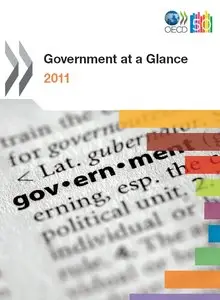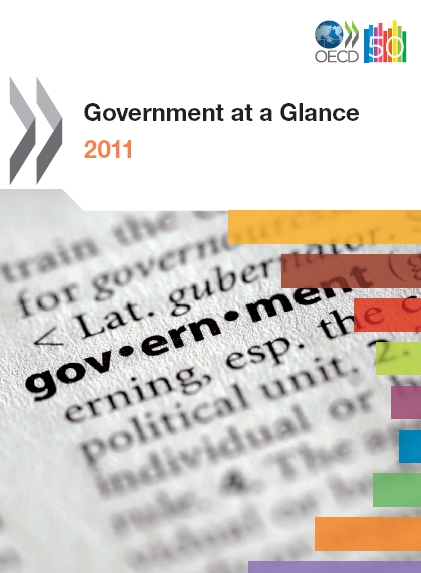Government at a Glance 2011
OECD | 24 June 2011 | ISBN: 9789264096578 9789264096585 | 268 pages | PDF | 3 MB
OECD | 24 June 2011 | ISBN: 9789264096578 9789264096585 | 268 pages | PDF | 3 MB
This second edition of Government at a Glance more than doubles the number of available indicators of OECD governments’ performance, to almost 60. The indicators compare the political and institutional frameworks of government across OECD countries as well as government revenues and expenditures, employment, and compensation.
Include indicators describing government policies and practices on integrity, e-government and open government, and introduce several composite indexes summarising key aspects of public management practices in human resources management, budgeting, procurement, and regulatory management.
The report also offers two special chapters, on leveraged governance and on the policy implications of fiscal consolidation.
Table of Contents
Preface
Reader’s Guide
Introduction
I. OECD 50th Anniversary – Leveraged Governance: Avoiding Fracture and Getting Results
Governance as performance: OECD style
Conclusions
II. Fiscal Consolidation: The Need for Evidence-Based Decision Making
Introduction
Most OECD countries are planning reforms to consolidate finances
Ability of the government to reform under pressure
Evaluating the quality of planned reforms: Key questions and risks
Conclusion
Bibliography
III. Public Finance and Economics
1. General government revenues
2. Structure of general government revenues
3. Revenue structure by level of government
4. General government expenditures
5. Structure of general government expenditures (by COFOG function)
6. Expenditures structure by level of government
7. General government expenditures by type
8. Production costs in general government
9. General government investment
10. Final consumption expenditures by government and households
11. Size of general government financial assets and liabilities
12. Government deficits/surpluses
13. General government debt
14. Special feature: Governments’ role in promoting R&D
IV. Strategic Foresight and Leadership
15. Fiscal sustainability
16. Strategic human resources management
17. Senior civil service
18. Political influence in senior staffing
19. Strategic decision making: Ministerial advisors
20. E-government strategies
V. Employment in General Government and Public Corporations
21. Employment in general government and public corporations
22. General government employment across levels of government
23. Ageing central government workforce
24. Special feature: Public workforce restructuring
VI. Compensation in Selected Public Sector Occupations
25. Teachers’ salaries
26. Doctors’ and nurses’ salaries
27. Compensation of senior management in central government
28. Compensation of middle management in central government
29. Compensation of professionals in central government
30. Compensation of secretarial staff in central government
VII. Human Resources Management Practices
31. Delegation in human resources management
32. Staff performance management
33. Industrial relations in central government
34. Working conditions in central government
VIII. Transparency in Governance
35. Legislative capacity to ensure transparency in the budget process
36. Scope of freedom of information laws
37. Ease of filing a request for public information
38. Proactive disclosure of information 142
39. Conflict-of-interest disclosure by top decision makers
IX. Public Procurement
40. Size of public procurement market
41. Transparency in public procurement
42. E-procurement
43. Special feature: Green procurement
X. Regulatory Governance
44. Regulatory institutional frameworks and oversight
45. Improving the transparency of regulations
46. Preparing for effective compliance and enforcement of regulations
47. Evaluating regulatory performance
XI. Ways of Delivering Public Services
48. Government outsourcing
49. Uptake of e-government services
50. Special feature: Partnering with citizens in service delivery
XII. Government Performance Indicators from Selected Sectors
51. Greater fairness through selected government policies
52. Equity in access to education
53. Education outputs
54. Education outcomes
55. Equity in access to health care
56. Health outputs and output-based efficiency measures
57. Health outcomes and expenditures
58. Efficiency of tax administrations
Annex A. Methodology for Revenue Aggregates
Annex B. Classification of the Functions of Government (COFOG)
Annex C. Fiscal Consolidation Model Assumptions
Annex D. Methodology and Additional Notes on Compensation of Government Employees
Annex E. Composite Indexes for Human Resources Management Practices
Annex F. Detailed Data on Conflict-of-Interest Disclosure
from the 2010 OECD Survey on Integrity
Annex G. Detailed Data from the 2010 OECD Survey on Public Procurement
Annex H. Contextual Factors
Annex I. Members of the Steering Group
Glossary
Bibliography
with TOC BookMarkLinks



